Lecture 9. Etymological background of the English vocabulary.

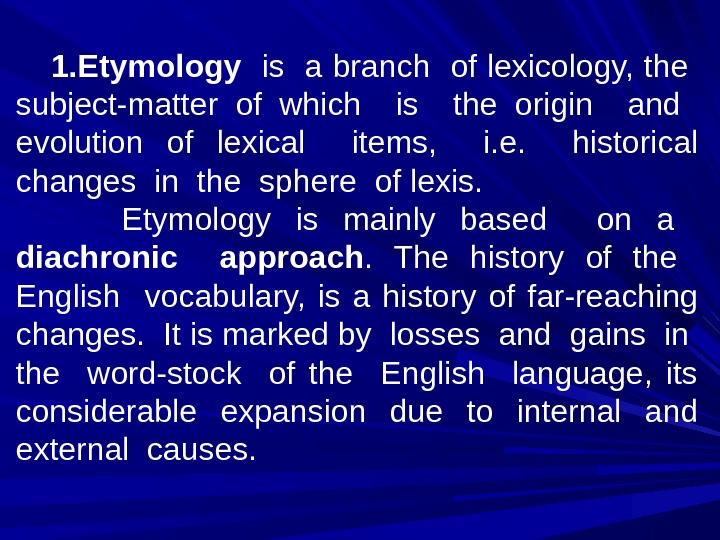
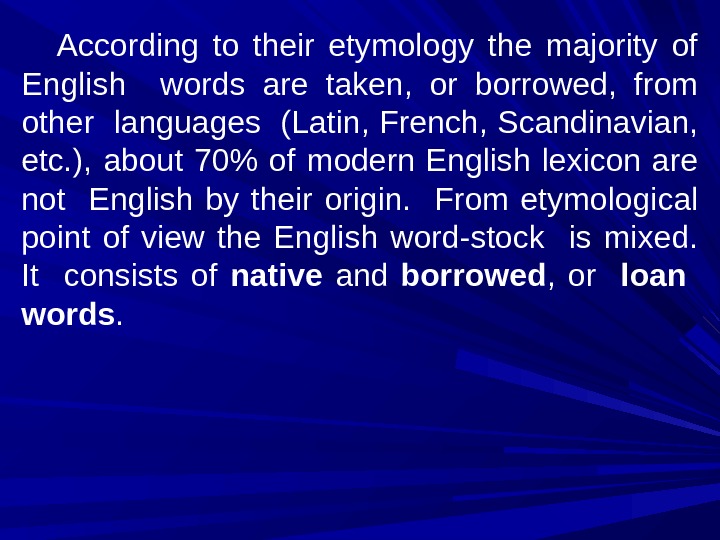
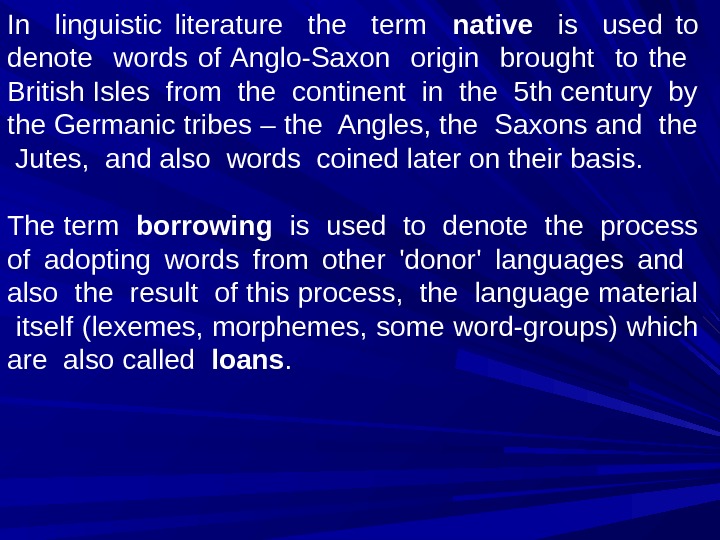
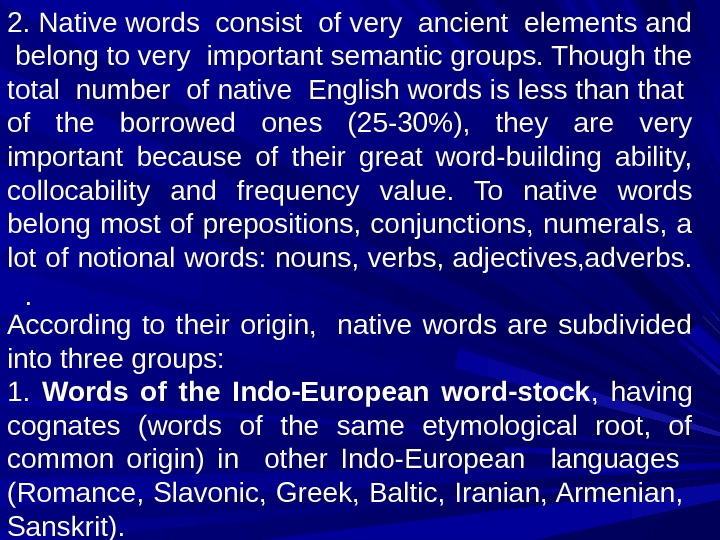
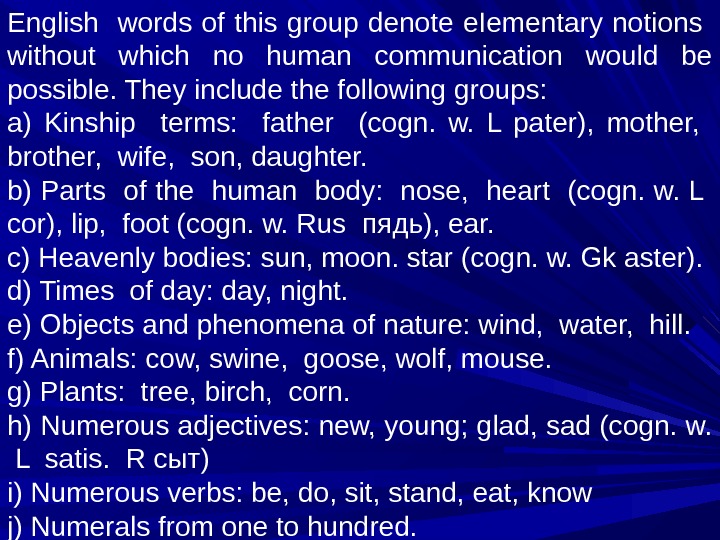
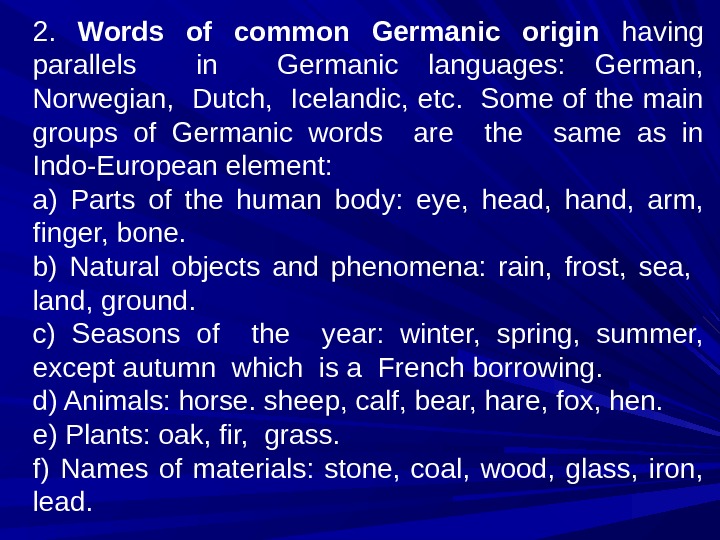
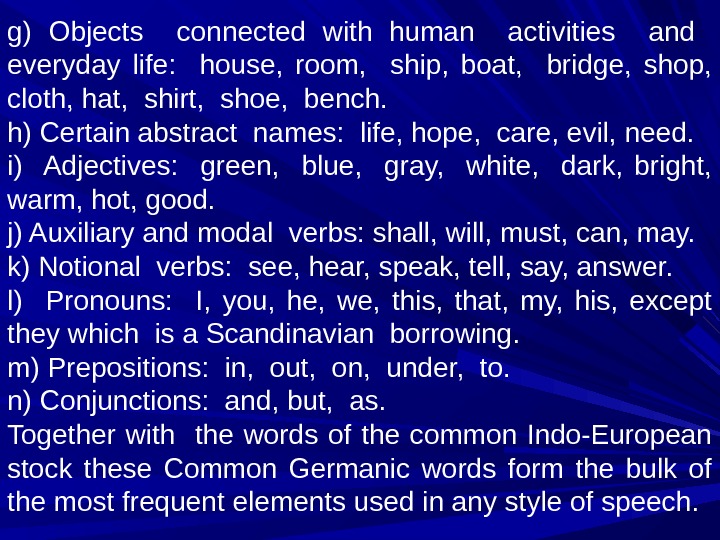
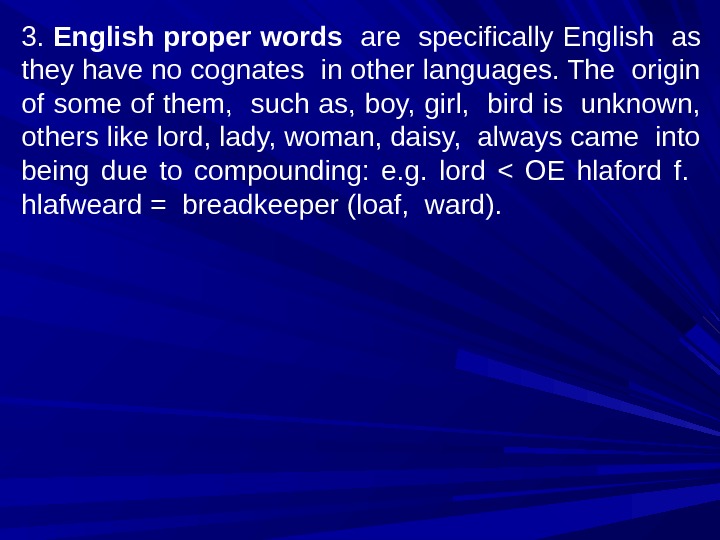
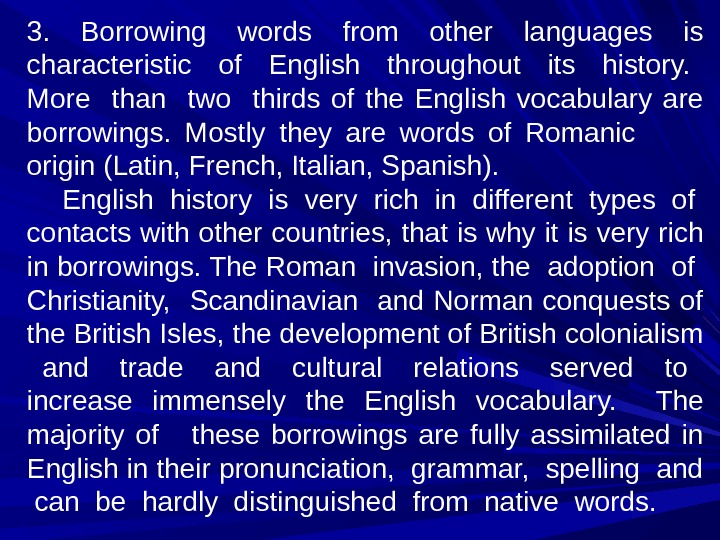
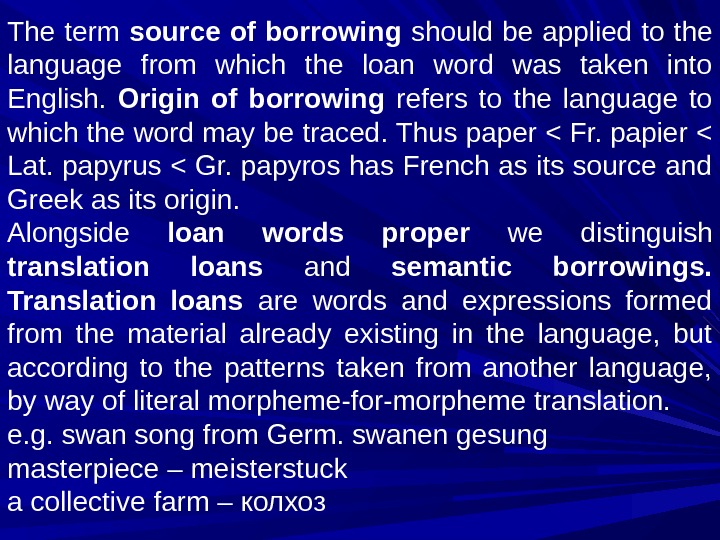

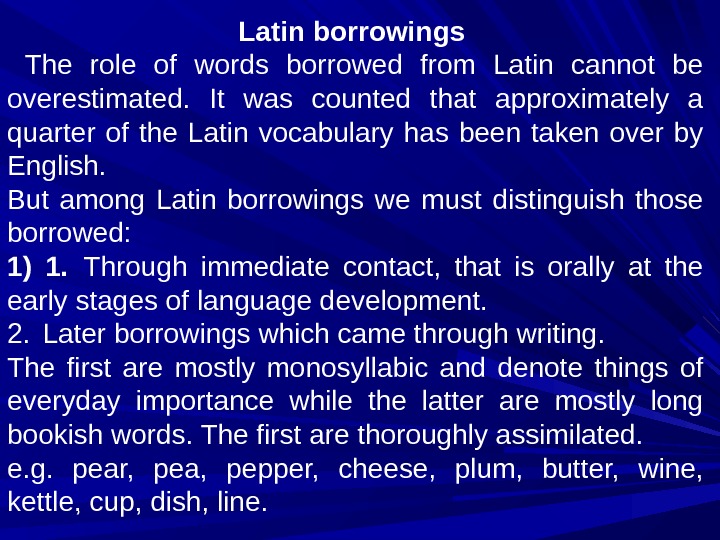
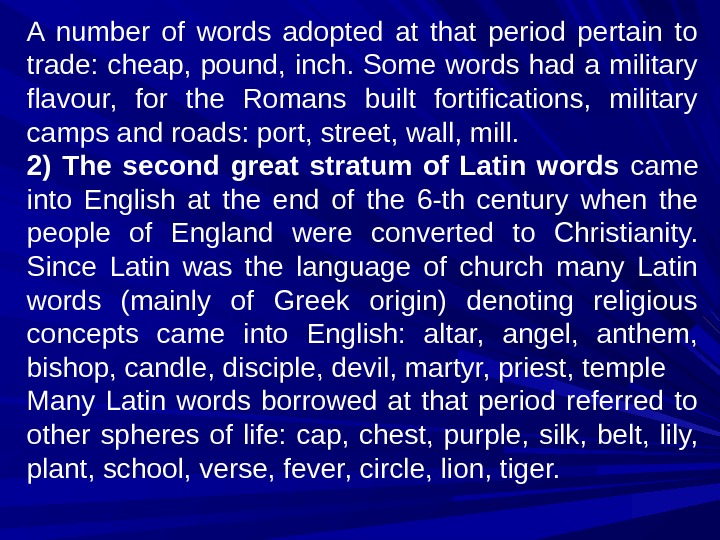
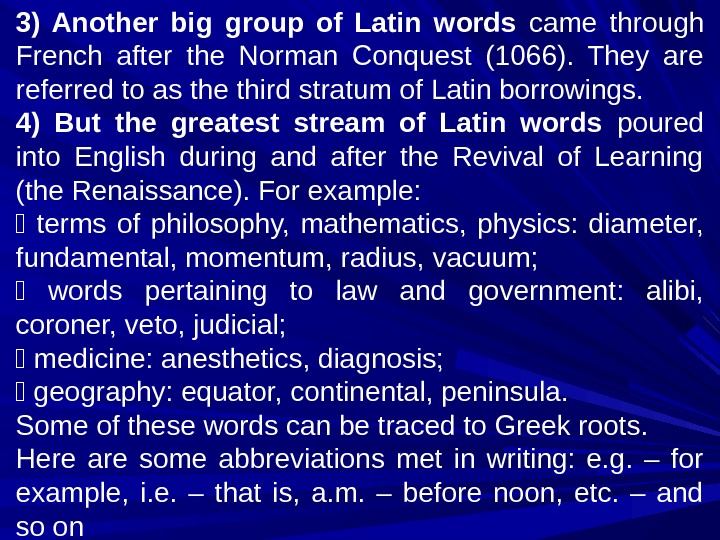

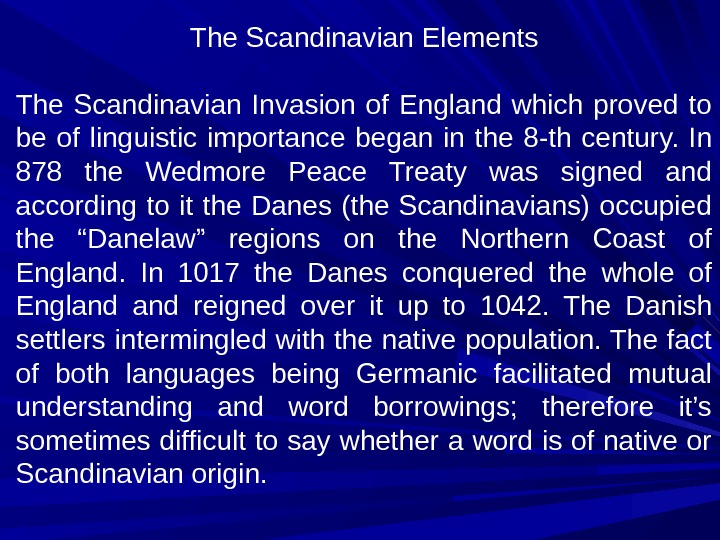
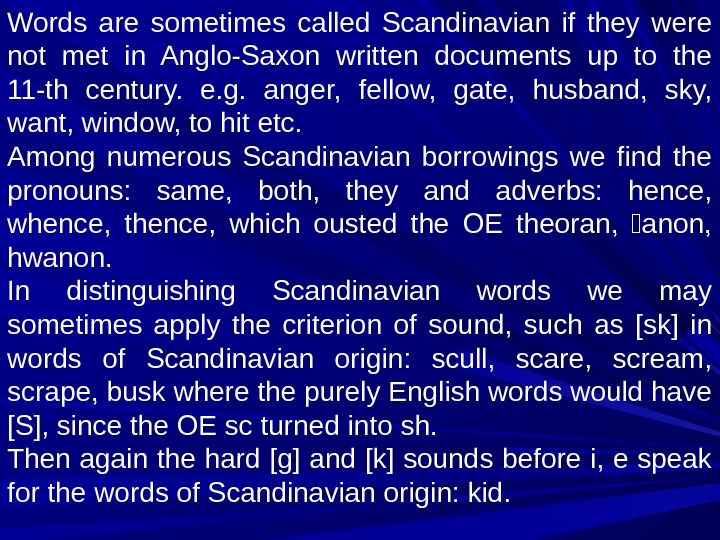
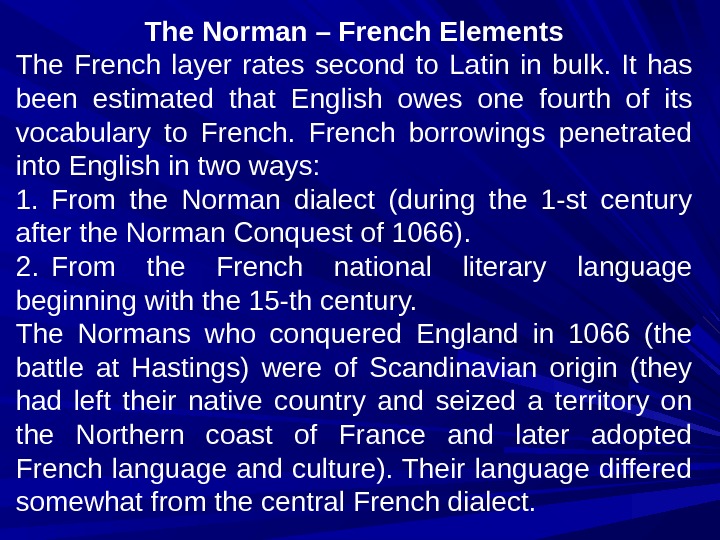

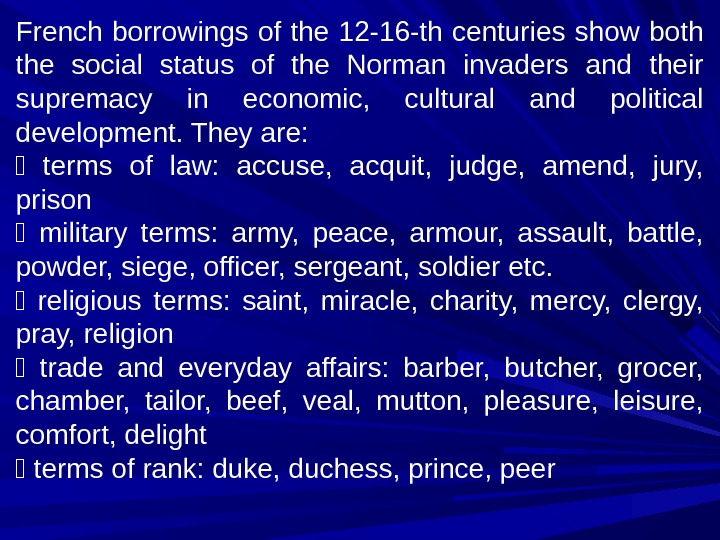
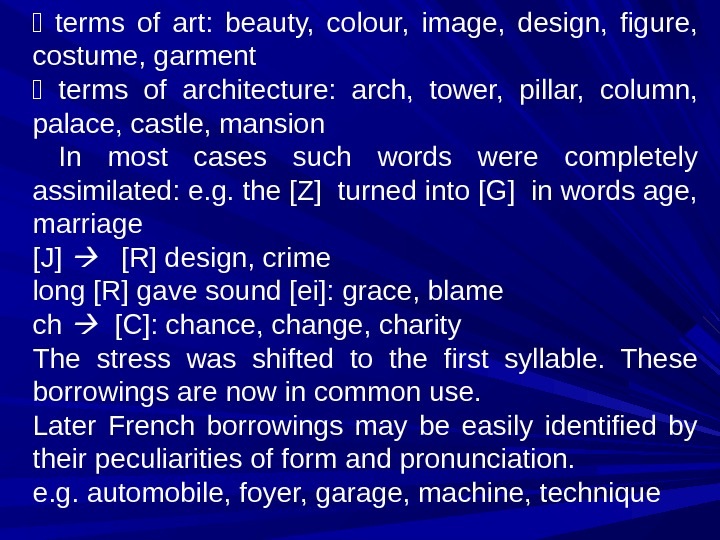
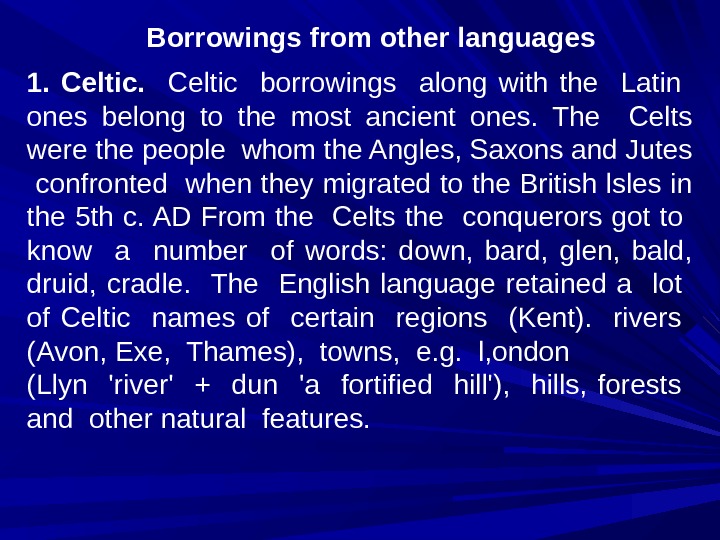
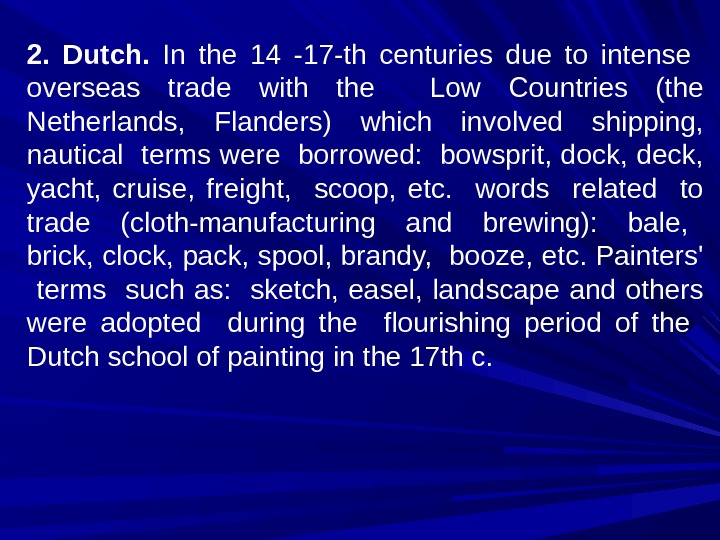
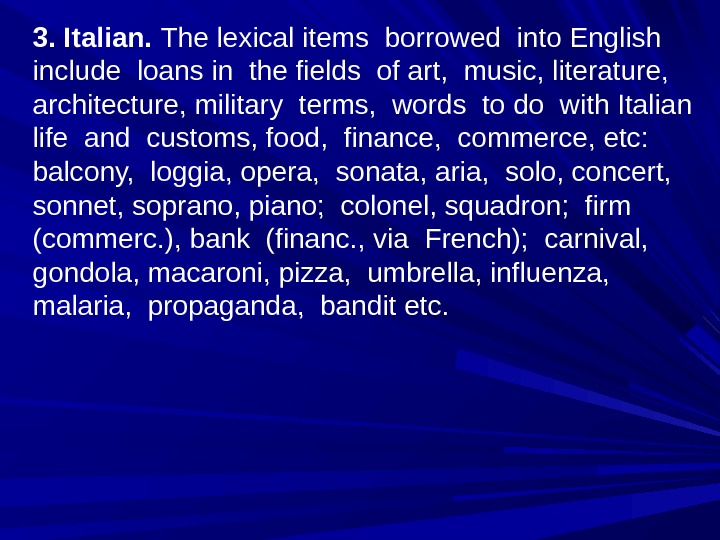
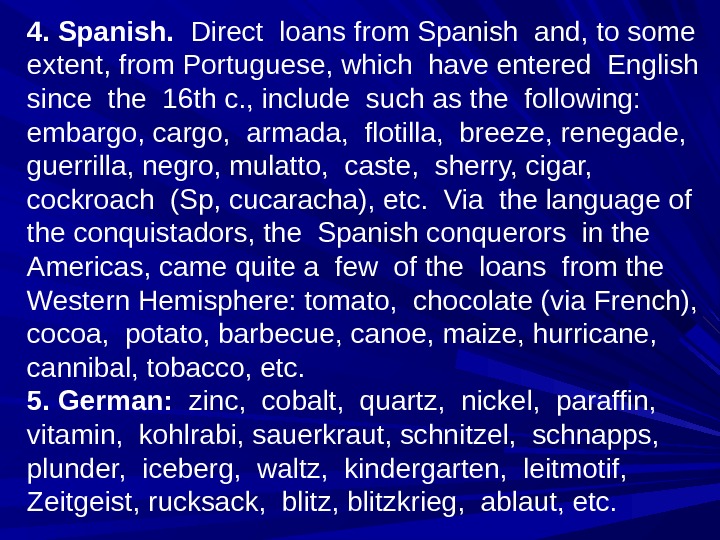

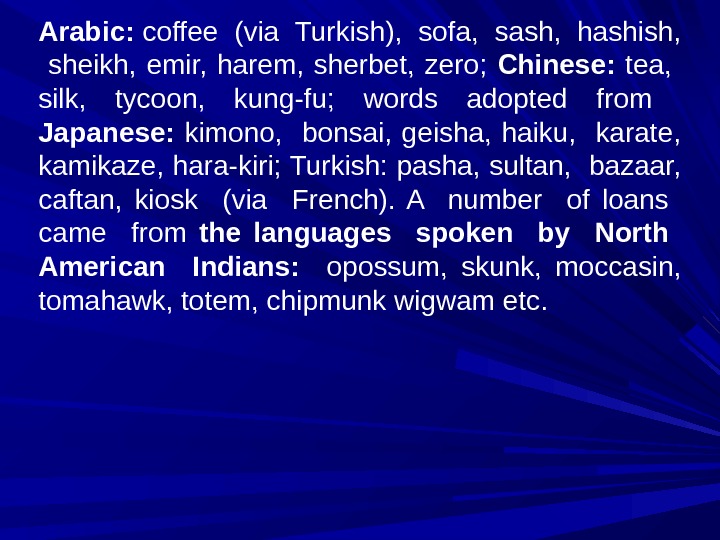
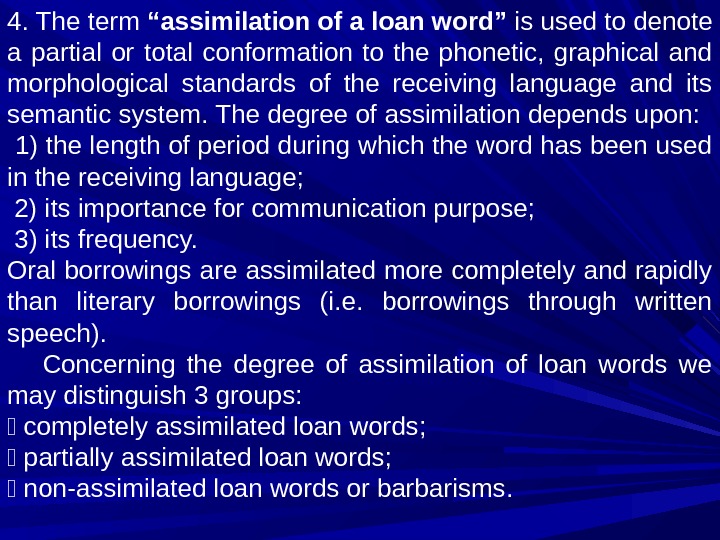
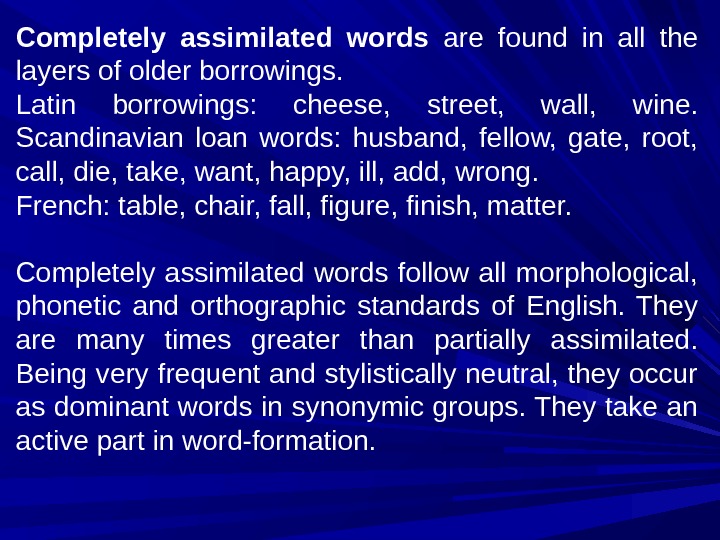
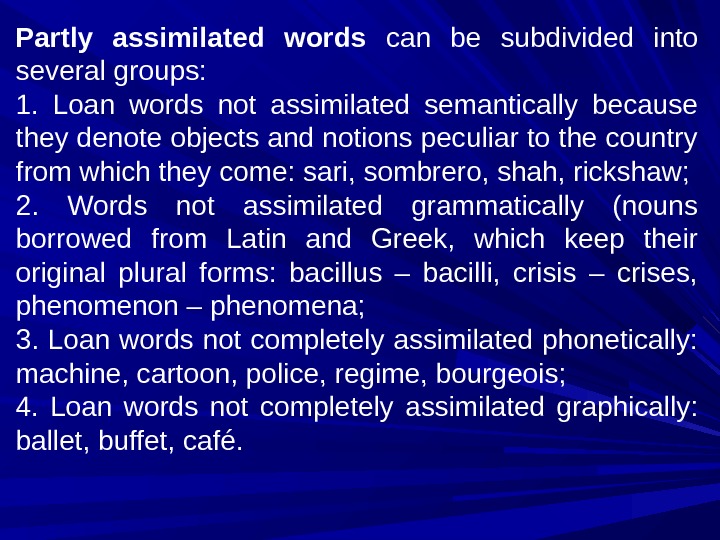
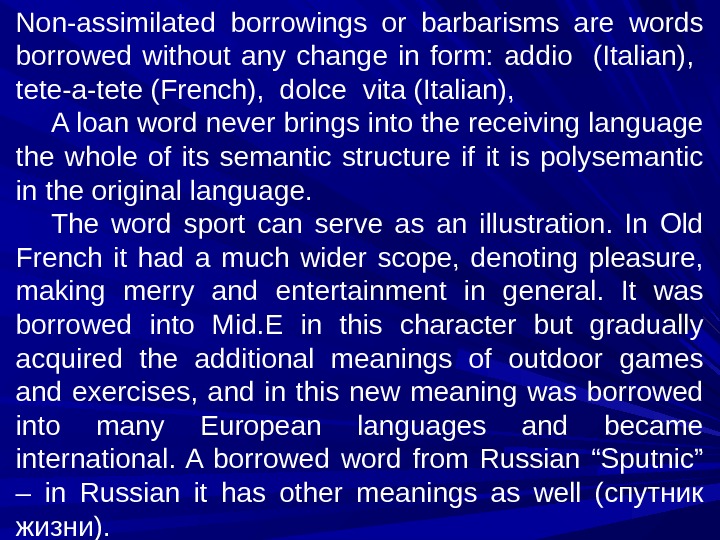
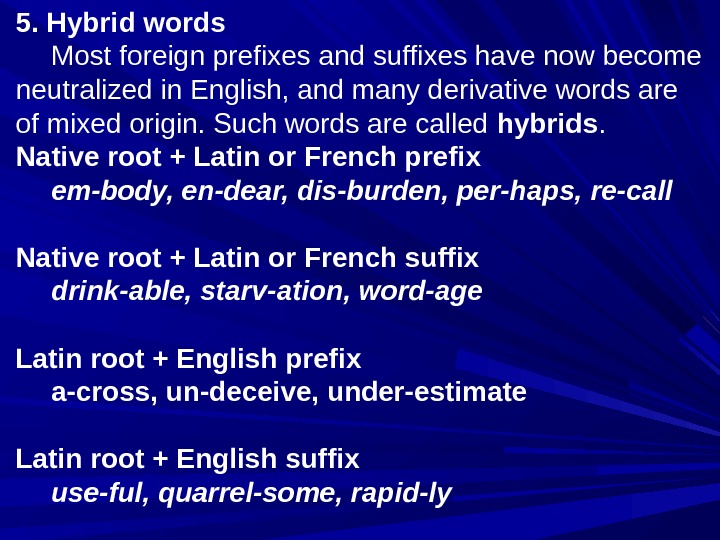

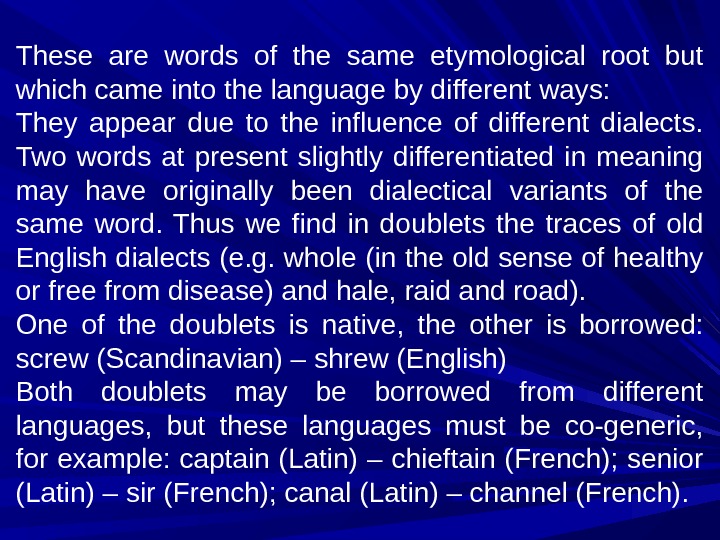
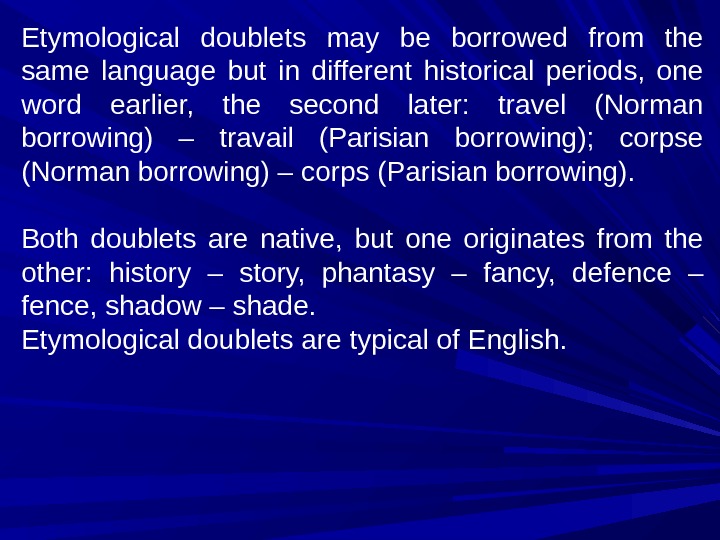
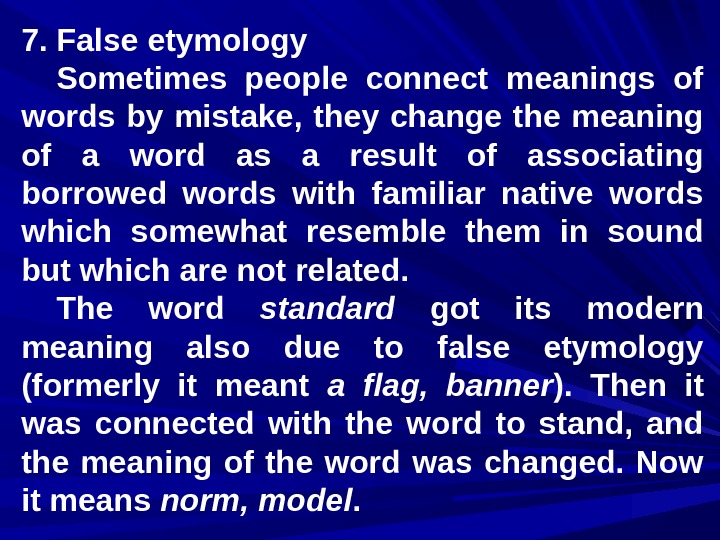



lexico_910_check_with_notes.ppt
- Размер: 228.5 Кб
- Количество слайдов: 40
Описание презентации Lecture 9. Etymological background of the English vocabulary. по слайдам
 Lecture 9. Etymological background of the English vocabulary. 1. Etymology as a branch of linguistics. 2. Native English vocabulary. 3. The role of borrowings in the formation of the English vocabulary. 4. Assimilation of borrowings. 5. Hybrid words 6. Etymological doublets. 7. False etymology. 8. International words.
Lecture 9. Etymological background of the English vocabulary. 1. Etymology as a branch of linguistics. 2. Native English vocabulary. 3. The role of borrowings in the formation of the English vocabulary. 4. Assimilation of borrowings. 5. Hybrid words 6. Etymological doublets. 7. False etymology. 8. International words.
 1. Etymology is a branch of lexicology, the subject-matter of which is the origin and evolution of lexical items, i. e. historical changes in the sphere of lexis. Etymology is mainly based on a diachronic approach. The history of the English vocabulary, is a history of far-reaching changes. It is marked by losses and gains in the word-stock of the English language, its considerable expansion due to internal and external causes.
1. Etymology is a branch of lexicology, the subject-matter of which is the origin and evolution of lexical items, i. e. historical changes in the sphere of lexis. Etymology is mainly based on a diachronic approach. The history of the English vocabulary, is a history of far-reaching changes. It is marked by losses and gains in the word-stock of the English language, its considerable expansion due to internal and external causes.
 According to their etymology the majority of English words are taken, or borrowed, from other languages (Latin, French, Scandinavian, etc. ), about 70% of modern English lexicon are not English by their origin. From etymological point of view the English word-stock is mixed. It consists of native and borrowed , or loan words.
According to their etymology the majority of English words are taken, or borrowed, from other languages (Latin, French, Scandinavian, etc. ), about 70% of modern English lexicon are not English by their origin. From etymological point of view the English word-stock is mixed. It consists of native and borrowed , or loan words.
 In linguistic literature the term native is used to denote words of Anglo-Saxon origin brought to the British Isles from the continent in the 5 th century by the Germanic tribes – the Angles, the Saxons and the Jutes, and also words coined later on their basis. The term borrowing is used to denote the process of adopting words from other ‘donor’ languages and also the result of this process, the language material itself (lexemes, morphemes, some word-groups) which are also called loans.
In linguistic literature the term native is used to denote words of Anglo-Saxon origin brought to the British Isles from the continent in the 5 th century by the Germanic tribes – the Angles, the Saxons and the Jutes, and also words coined later on their basis. The term borrowing is used to denote the process of adopting words from other ‘donor’ languages and also the result of this process, the language material itself (lexemes, morphemes, some word-groups) which are also called loans.
 . 2. Native words consist of very ancient elements and belong to very important semantic groups. Though the total number of native English words is less than that of the borrowed ones (25 -30%), they are very important because of their great word-building ability, collocability and frequency value. To native words belong most of prepositions, conjunctions, numera. Is, a lot of notional words: nouns, verbs, adjectives, adverbs. According to their origin, native words are subdivided into three groups: 1. Words of the Indo-European word-stock , having cognates (words of the same etymological root, of common origin) in other Indo-European languages (Romance, Slavonic, Greek, Baltic, Iranian, Armenian, Sanskrit).
. 2. Native words consist of very ancient elements and belong to very important semantic groups. Though the total number of native English words is less than that of the borrowed ones (25 -30%), they are very important because of their great word-building ability, collocability and frequency value. To native words belong most of prepositions, conjunctions, numera. Is, a lot of notional words: nouns, verbs, adjectives, adverbs. According to their origin, native words are subdivided into three groups: 1. Words of the Indo-European word-stock , having cognates (words of the same etymological root, of common origin) in other Indo-European languages (Romance, Slavonic, Greek, Baltic, Iranian, Armenian, Sanskrit).
 English words of this group denote e. Iementary notions without which no human communication would be possible. They include the following groups: a) Kinship terms: father (cogn. w. L pater), mother, brother, wife, son, daughter. b) Parts of the human body: nose, heart (cogn. w. L cor), lip, foot (cogn. w. Rus пядь) , ear. с ) Heavenly bodies: sun, moon. star (cogn. w. Gk aster). d) Times of day: day, night. e) Objects and phenomena of nature: wind, water, hill. f) Animals: cow, swine, goose, wolf, mouse. g) Plants: tree, birch, corn. h) Numerous adjectives: new, young; glad, sad (cogn. w. L satis. R сыт) i) Numerous verbs: be, do, sit, stand, eat, know j) Numerals from one to hundred.
English words of this group denote e. Iementary notions without which no human communication would be possible. They include the following groups: a) Kinship terms: father (cogn. w. L pater), mother, brother, wife, son, daughter. b) Parts of the human body: nose, heart (cogn. w. L cor), lip, foot (cogn. w. Rus пядь) , ear. с ) Heavenly bodies: sun, moon. star (cogn. w. Gk aster). d) Times of day: day, night. e) Objects and phenomena of nature: wind, water, hill. f) Animals: cow, swine, goose, wolf, mouse. g) Plants: tree, birch, corn. h) Numerous adjectives: new, young; glad, sad (cogn. w. L satis. R сыт) i) Numerous verbs: be, do, sit, stand, eat, know j) Numerals from one to hundred.
 2. Words of common Germanic origin having parallels in Germanic languages: German, Norwegian, Dutch, Icelandic, etc. Some of the main groups of Germanic words are the same as in Indo-European element: a) Parts of the human body: eye, head, hand, arm, finger, bone. b) Natural objects and phenomena: rain, frost, sea, land, ground. c) Seasons of the year: winter, spring, summer, except autumn which is a French borrowing. d) Animals: horse. sheep, calf, bear, hare, fox, hen. e) Plants: oak, fir, grass. f) Names of materials: stone, coal, wood, glass, iron, lead.
2. Words of common Germanic origin having parallels in Germanic languages: German, Norwegian, Dutch, Icelandic, etc. Some of the main groups of Germanic words are the same as in Indo-European element: a) Parts of the human body: eye, head, hand, arm, finger, bone. b) Natural objects and phenomena: rain, frost, sea, land, ground. c) Seasons of the year: winter, spring, summer, except autumn which is a French borrowing. d) Animals: horse. sheep, calf, bear, hare, fox, hen. e) Plants: oak, fir, grass. f) Names of materials: stone, coal, wood, glass, iron, lead.
 g) Objects connected with human activities and everyday life: house, room, ship, boat, bridge, shop, cloth, hat, shirt, shoe, bench. h) Certain abstract names: life, hope, care, evil, need. i) Adjectives: green, blue, gray, white, dark, bright, warm, hot, good. j) Auxiliary and modal verbs: shall, will, must, can, may. k) Notional verbs: see, hear, speak, tell, say, answer. l) Pronouns: I, you, he, we, this, that, my, his, except they which is a Scandinavian borrowing. m) Prepositions: in, out, on, under, to. n) Conjunctions: and, but, as. Together with the words of the common Indo-European stock these Common Germanic words form the bulk of the most frequent elements used in any style of speech.
g) Objects connected with human activities and everyday life: house, room, ship, boat, bridge, shop, cloth, hat, shirt, shoe, bench. h) Certain abstract names: life, hope, care, evil, need. i) Adjectives: green, blue, gray, white, dark, bright, warm, hot, good. j) Auxiliary and modal verbs: shall, will, must, can, may. k) Notional verbs: see, hear, speak, tell, say, answer. l) Pronouns: I, you, he, we, this, that, my, his, except they which is a Scandinavian borrowing. m) Prepositions: in, out, on, under, to. n) Conjunctions: and, but, as. Together with the words of the common Indo-European stock these Common Germanic words form the bulk of the most frequent elements used in any style of speech.
 3. English proper words are specifically English as they have no cognates in other languages. The origin of some of them, such as, boy, girl, bird is unknown, others like lord, lady, woman, daisy, always came into being due to compounding: e. g. lord < OE hlaford f. hlafweard = breadkeeper (loaf, ward).
3. English proper words are specifically English as they have no cognates in other languages. The origin of some of them, such as, boy, girl, bird is unknown, others like lord, lady, woman, daisy, always came into being due to compounding: e. g. lord < OE hlaford f. hlafweard = breadkeeper (loaf, ward).
 3. Borrowing words from other languages is characteristic of English throughout its history. More than two thirds of the English vocabulary are borrowings. Mostly they are words of Romanic origin (Latin, French, Italian, Spanish). English history is very rich in different types of contacts with other countries, that is why it is very rich in borrowings. The Roman invasion, the adoption of Christianity, Scandinavian and Norman conquests of the British Isles, the development of British colonialism and trade and cultural relations served to increase immensely the English vocabulary. The majority of these borrowings are fully assimilated in English in their pronunciation, grammar, spelling and can be hardly distinguished from native words.
3. Borrowing words from other languages is characteristic of English throughout its history. More than two thirds of the English vocabulary are borrowings. Mostly they are words of Romanic origin (Latin, French, Italian, Spanish). English history is very rich in different types of contacts with other countries, that is why it is very rich in borrowings. The Roman invasion, the adoption of Christianity, Scandinavian and Norman conquests of the British Isles, the development of British colonialism and trade and cultural relations served to increase immensely the English vocabulary. The majority of these borrowings are fully assimilated in English in their pronunciation, grammar, spelling and can be hardly distinguished from native words.
 The term source of borrowing should be applied to the language from which the loan word was taken into English. Origin of borrowing refers to the language to which the word may be traced. Thus paper < Fr. papier < Lat. papyrus < Gr. papyros has French as its source and Greek as its origin. Alongside loan words proper we distinguish translation loans and semantic borrowings. Translation loans are words and expressions formed from the material already existing in the language, but according to the patterns taken from another language, by way of literal morpheme-for-morpheme translation. e. g. swan song from Germ. swanen gesung masterpiece – meisterstuck a collective farm – колхоз
The term source of borrowing should be applied to the language from which the loan word was taken into English. Origin of borrowing refers to the language to which the word may be traced. Thus paper < Fr. papier < Lat. papyrus < Gr. papyros has French as its source and Greek as its origin. Alongside loan words proper we distinguish translation loans and semantic borrowings. Translation loans are words and expressions formed from the material already existing in the language, but according to the patterns taken from another language, by way of literal morpheme-for-morpheme translation. e. g. swan song from Germ. swanen gesung masterpiece – meisterstuck a collective farm – колхоз
 The term semantic loan is used to denote the development in an English word of a new meaning due to the influence of a related word in another language. The English word “pioneer” meant “explorer” and one who is the first. Under the influence of the Russian word “пионер” it has come to mean “a member of the Young Pioneer Organization”. “ Dwell” – “to wander about” (under the influence of Scandinavian — “to live”).
The term semantic loan is used to denote the development in an English word of a new meaning due to the influence of a related word in another language. The English word “pioneer” meant “explorer” and one who is the first. Under the influence of the Russian word “пионер” it has come to mean “a member of the Young Pioneer Organization”. “ Dwell” – “to wander about” (under the influence of Scandinavian — “to live”).
 Latin borrowings The role of words borrowed from Latin cannot be overestimated. It was counted that approximately a quarter of the Latin vocabulary has been taken over by English. But among Latin borrowings we must distinguish those borrowed: 1) 1. Through immediate contact, that is orally at the early stages of language development. 2. Later borrowings which came through writing. The first are mostly monosyllabic and denote things of everyday importance while the latter are mostly long bookish words. The first are thoroughly assimilated. e. g. pear, pea, pepper, cheese, plum, butter, wine, kettle, cup, dish, line.
Latin borrowings The role of words borrowed from Latin cannot be overestimated. It was counted that approximately a quarter of the Latin vocabulary has been taken over by English. But among Latin borrowings we must distinguish those borrowed: 1) 1. Through immediate contact, that is orally at the early stages of language development. 2. Later borrowings which came through writing. The first are mostly monosyllabic and denote things of everyday importance while the latter are mostly long bookish words. The first are thoroughly assimilated. e. g. pear, pea, pepper, cheese, plum, butter, wine, kettle, cup, dish, line.
 A number of words adopted at that period pertain to trade: cheap, pound, inch. Some words had a military flavour, for the Romans built fortifications, military camps and roads: port, street, wall, mill. 2) The second great stratum of Latin words came into English at the end of the 6 -th century when the people of England were converted to Christianity. Since Latin was the language of church many Latin words (mainly of Greek origin) denoting religious concepts came into English: altar, angel, anthem, bishop, candle, disciple, devil, martyr, priest, temple Many Latin words borrowed at that period referred to other spheres of life: cap, chest, purple, silk, belt, lily, plant, school, verse, fever, circle, lion, tiger.
A number of words adopted at that period pertain to trade: cheap, pound, inch. Some words had a military flavour, for the Romans built fortifications, military camps and roads: port, street, wall, mill. 2) The second great stratum of Latin words came into English at the end of the 6 -th century when the people of England were converted to Christianity. Since Latin was the language of church many Latin words (mainly of Greek origin) denoting religious concepts came into English: altar, angel, anthem, bishop, candle, disciple, devil, martyr, priest, temple Many Latin words borrowed at that period referred to other spheres of life: cap, chest, purple, silk, belt, lily, plant, school, verse, fever, circle, lion, tiger.
 3) Another big group of Latin words came through French after the Norman Conquest (1066). They are referred to as the third stratum of Latin borrowings. 4) But the greatest stream of Latin words poured into English during and after the Revival of Learning (the Renaissance). For example: terms of philosophy, mathematics, physics: diameter, fundamental, momentum, radius, vacuum; words pertaining to law and government: alibi, coroner, veto, judicial; medicine: anesthetics, diagnosis; geography: equator, continental, peninsula. Some of these words can be traced to Greek roots. Here are some abbreviations met in writing: e. g. – for example, i. e. – that is, a. m. – before noon, etc. – and so on
3) Another big group of Latin words came through French after the Norman Conquest (1066). They are referred to as the third stratum of Latin borrowings. 4) But the greatest stream of Latin words poured into English during and after the Revival of Learning (the Renaissance). For example: terms of philosophy, mathematics, physics: diameter, fundamental, momentum, radius, vacuum; words pertaining to law and government: alibi, coroner, veto, judicial; medicine: anesthetics, diagnosis; geography: equator, continental, peninsula. Some of these words can be traced to Greek roots. Here are some abbreviations met in writing: e. g. – for example, i. e. – that is, a. m. – before noon, etc. – and so on
 Greek Borrowings
Greek Borrowings
 The Scandinavian Elements The Scandinavian Invasion of England which proved to be of linguistic importance began in the 8 -th century. In 878 the Wedmore Peace Treaty was signed and according to it the Danes (the Scandinavians) occupied the “Danelaw” regions on the Northern Coast of England. In 1017 the Danes conquered the whole of England reigned over it up to 1042. The Danish settlers intermingled with the native population. The fact of both languages being Germanic facilitated mutual understanding and word borrowings; therefore it’s sometimes difficult to say whether a word is of native or Scandinavian origin.
The Scandinavian Elements The Scandinavian Invasion of England which proved to be of linguistic importance began in the 8 -th century. In 878 the Wedmore Peace Treaty was signed and according to it the Danes (the Scandinavians) occupied the “Danelaw” regions on the Northern Coast of England. In 1017 the Danes conquered the whole of England reigned over it up to 1042. The Danish settlers intermingled with the native population. The fact of both languages being Germanic facilitated mutual understanding and word borrowings; therefore it’s sometimes difficult to say whether a word is of native or Scandinavian origin.
 Words are sometimes called Scandinavian if they were not met in Anglo-Saxon written documents up to the 11 -th century. e. g. anger, fellow, gate, husband, sky, want, window, to hit etc. Among numerous Scandinavian borrowings we find the pronouns: same, both, they and adverbs: hence, whence, thence, which ousted the OE theoran, anon, hwanon. In distinguishing Scandinavian words we may sometimes apply the criterion of sound, such as [sk] in words of Scandinavian origin: scull, scare, scream, scrape, busk where the purely English words would have [S], since the OE sc turned into sh. Then again the hard [g] and [k] sounds before i, e speak for the words of Scandinavian origin: kid.
Words are sometimes called Scandinavian if they were not met in Anglo-Saxon written documents up to the 11 -th century. e. g. anger, fellow, gate, husband, sky, want, window, to hit etc. Among numerous Scandinavian borrowings we find the pronouns: same, both, they and adverbs: hence, whence, thence, which ousted the OE theoran, anon, hwanon. In distinguishing Scandinavian words we may sometimes apply the criterion of sound, such as [sk] in words of Scandinavian origin: scull, scare, scream, scrape, busk where the purely English words would have [S], since the OE sc turned into sh. Then again the hard [g] and [k] sounds before i, e speak for the words of Scandinavian origin: kid.
 The Norman – French Elements The French layer rates second to Latin in bulk. It has been estimated that English owes one fourth of its vocabulary to French borrowings penetrated into English in two ways: 1. From the Norman dialect (during the 1 -st century after the Norman Conquest of 1066). 2. From the French national literary language beginning with the 15 -th century. The Normans who conquered England in 1066 (the battle at Hastings) were of Scandinavian origin (they had left their native country and seized a territory on the Northern coast of France and later adopted French language and culture). Their language differed somewhat from the central French dialect.
The Norman – French Elements The French layer rates second to Latin in bulk. It has been estimated that English owes one fourth of its vocabulary to French borrowings penetrated into English in two ways: 1. From the Norman dialect (during the 1 -st century after the Norman Conquest of 1066). 2. From the French national literary language beginning with the 15 -th century. The Normans who conquered England in 1066 (the battle at Hastings) were of Scandinavian origin (they had left their native country and seized a territory on the Northern coast of France and later adopted French language and culture). Their language differed somewhat from the central French dialect.
 During two centuries after the Norman Conquest the linguistic situation in England was rather complicated: the feudal lords spoke the Norman dialect (Norman French), the ordinary people spoke English, scientific and religious literature was in Latin, the court documents, fiction were written in French. Latin and French were used in administration and school teaching. The Anglo-Norman dialect which was a good conductor of French words which penetrated into English in great numbers. Gradually English assimilated many French words that either ousted their Saxon equivalents or became synonymous to native words. e. g. happiness – felicity, help – aid, weak – feeble Before the Norman Conquest only a few words were borrowed (proud, turn, false, chancellor, market).
During two centuries after the Norman Conquest the linguistic situation in England was rather complicated: the feudal lords spoke the Norman dialect (Norman French), the ordinary people spoke English, scientific and religious literature was in Latin, the court documents, fiction were written in French. Latin and French were used in administration and school teaching. The Anglo-Norman dialect which was a good conductor of French words which penetrated into English in great numbers. Gradually English assimilated many French words that either ousted their Saxon equivalents or became synonymous to native words. e. g. happiness – felicity, help – aid, weak – feeble Before the Norman Conquest only a few words were borrowed (proud, turn, false, chancellor, market).
 French borrowings of the 12 -16 -th centuries show both the social status of the Norman invaders and their supremacy in economic, cultural and political development. They are: terms of law: accuse, acquit, judge, amend, jury, prison military terms: army, peace, armour, assault, battle, powder, siege, officer, sergeant, soldier etc. religious terms: saint, miracle, charity, mercy, clergy, pray, religion trade and everyday affairs: barber, butcher, grocer, chamber, tailor, beef, veal, mutton, pleasure, leisure, comfort, delight terms of rank: duke, duchess, prince, peer
French borrowings of the 12 -16 -th centuries show both the social status of the Norman invaders and their supremacy in economic, cultural and political development. They are: terms of law: accuse, acquit, judge, amend, jury, prison military terms: army, peace, armour, assault, battle, powder, siege, officer, sergeant, soldier etc. religious terms: saint, miracle, charity, mercy, clergy, pray, religion trade and everyday affairs: barber, butcher, grocer, chamber, tailor, beef, veal, mutton, pleasure, leisure, comfort, delight terms of rank: duke, duchess, prince, peer
 terms of art: beauty, colour, image, design, figure, costume, garment terms of architecture: arch, tower, pillar, column, palace, castle, mansion In most cases such words were completely assimilated: e. g. the [Z] turned into [G] in words age, marriage [J] [R] design, crime long [R] gave sound [ei]: grace, blame ch [C]: chance, change, charity The stress was shifted to the first syllable. These borrowings are now in common use. Later French borrowings may be easily identified by their peculiarities of form and pronunciation. e. g. automobile, foyer, garage, machine, technique
terms of art: beauty, colour, image, design, figure, costume, garment terms of architecture: arch, tower, pillar, column, palace, castle, mansion In most cases such words were completely assimilated: e. g. the [Z] turned into [G] in words age, marriage [J] [R] design, crime long [R] gave sound [ei]: grace, blame ch [C]: chance, change, charity The stress was shifted to the first syllable. These borrowings are now in common use. Later French borrowings may be easily identified by their peculiarities of form and pronunciation. e. g. automobile, foyer, garage, machine, technique
 Borrowings from other languages 1. Celtic borrowings along with the Latin ones belong to the most ancient ones. The Celts were the people whom the Angles, Saxons and Jutes confronted when they migrated to the British lsles in the 5 th c. AD From the Celts the conquerors got to know a number of words: down, bard, glen, bald, druid, cradle. The English language retained a lot of Celtic names of certain regions (Kent). rivers (Avon, Exe, Thames), towns, e. g. l, ondon (Llyn ‘river’ + dun ‘a fortified hill’), hills, forests and other natural features.
Borrowings from other languages 1. Celtic borrowings along with the Latin ones belong to the most ancient ones. The Celts were the people whom the Angles, Saxons and Jutes confronted when they migrated to the British lsles in the 5 th c. AD From the Celts the conquerors got to know a number of words: down, bard, glen, bald, druid, cradle. The English language retained a lot of Celtic names of certain regions (Kent). rivers (Avon, Exe, Thames), towns, e. g. l, ondon (Llyn ‘river’ + dun ‘a fortified hill’), hills, forests and other natural features.
 2. Dutch. In the 14 -17 -th centuries due to intense overseas trade with the Low Countries (the Netherlands, Flanders) which involved shipping, nautical terms were borrowed: bowsprit, dock, deck, yacht, cruise, freight, scoop, etc. words related to trade (cloth-manufacturing and brewing): bale, brick, clock, pack, spool, brandy, booze, etc. Painters’ terms such as: sketch, easel, landscape and others were adopted during the flourishing period of the Dutch school of painting in the 17 th c.
2. Dutch. In the 14 -17 -th centuries due to intense overseas trade with the Low Countries (the Netherlands, Flanders) which involved shipping, nautical terms were borrowed: bowsprit, dock, deck, yacht, cruise, freight, scoop, etc. words related to trade (cloth-manufacturing and brewing): bale, brick, clock, pack, spool, brandy, booze, etc. Painters’ terms such as: sketch, easel, landscape and others were adopted during the flourishing period of the Dutch school of painting in the 17 th c.
 3. Italian. The lexical items borrowed into English include loans in the fields of art, music, literature, architecture, military terms, words to do with Italian life and customs, food, finance, commerce, etc: balcony, loggia, opera, sonata, aria, solo, concert, sonnet, soprano, piano; colonel, squadron; firm (commerc. ), bank (financ. , via French); carnival, gondola, macaroni, pizza, umbrella, influenza, malaria, propaganda, bandit etc.
3. Italian. The lexical items borrowed into English include loans in the fields of art, music, literature, architecture, military terms, words to do with Italian life and customs, food, finance, commerce, etc: balcony, loggia, opera, sonata, aria, solo, concert, sonnet, soprano, piano; colonel, squadron; firm (commerc. ), bank (financ. , via French); carnival, gondola, macaroni, pizza, umbrella, influenza, malaria, propaganda, bandit etc.
 4. Spanish. Direct loans from Spanish and, to some extent, from Portuguese, which have entered English since the 16 th c. , include such as the following: embargo, cargo, armada, flotilla, breeze, renegade, guerrilla, negro, mulatto, caste, sherry, cigar, cockroach (Sp, cucaracha), etc. Via the language of the conquistadors, the Spanish conquerors in the Americas, came quite a few of the loans from the Western Hemisphere: tomato, chocolate (via French), cocoa, potato, barbecue, canoe, maize, hurricane, cannibal, tobacco, etc. 5. German: zinc, cobalt, quartz, nickel, paraffin, vitamin, kohlrabi, sauerkraut, schnitzel, schnapps, plunder, iceberg, waltz, kindergarten, leitmotif, Zeitgeist, rucksack, blitz, blitzkrieg, ablaut, etc.
4. Spanish. Direct loans from Spanish and, to some extent, from Portuguese, which have entered English since the 16 th c. , include such as the following: embargo, cargo, armada, flotilla, breeze, renegade, guerrilla, negro, mulatto, caste, sherry, cigar, cockroach (Sp, cucaracha), etc. Via the language of the conquistadors, the Spanish conquerors in the Americas, came quite a few of the loans from the Western Hemisphere: tomato, chocolate (via French), cocoa, potato, barbecue, canoe, maize, hurricane, cannibal, tobacco, etc. 5. German: zinc, cobalt, quartz, nickel, paraffin, vitamin, kohlrabi, sauerkraut, schnitzel, schnapps, plunder, iceberg, waltz, kindergarten, leitmotif, Zeitgeist, rucksack, blitz, blitzkrieg, ablaut, etc.
 6. Russian borrowings are subdivided into: a) pre-Revolutionary: samovar, tsar, steppe, vodka, kvass, knout, borsch, troika, steppe, verst, sable, sevruga, babushka, intelligentsia; b) post-Revolutionary: Soviet, bolshevik, kolkhoz, sputnik, perestroika, glasnost, pryzhok, etc. The age of colonialist expansion brought English into direct contact with languages from all parts of the world and resulted in numerous additions to its vocabulary, e. g. from the languages spoken on the Indian sub-continent: jungle, pyjamas, khaki, yoga, bungalow, verandah. guru, shampoo, etc. From the Malay-Polynesian and the languages of the Australian aborigines came borrowings like gong, taboo, boomerang.
6. Russian borrowings are subdivided into: a) pre-Revolutionary: samovar, tsar, steppe, vodka, kvass, knout, borsch, troika, steppe, verst, sable, sevruga, babushka, intelligentsia; b) post-Revolutionary: Soviet, bolshevik, kolkhoz, sputnik, perestroika, glasnost, pryzhok, etc. The age of colonialist expansion brought English into direct contact with languages from all parts of the world and resulted in numerous additions to its vocabulary, e. g. from the languages spoken on the Indian sub-continent: jungle, pyjamas, khaki, yoga, bungalow, verandah. guru, shampoo, etc. From the Malay-Polynesian and the languages of the Australian aborigines came borrowings like gong, taboo, boomerang.
 Arabic: coffee (via Turkish), sofa, sash, hashish, sheikh, emir, harem, sherbet, zero; Chinese: tea, silk, tycoon, kung-fu; words adopted from Japanese: kimono, bonsai, geisha, haiku, karate, kamikaze, hara-kiri; Turkish: pasha, sultan, bazaar, caftan, kiosk (via French). A number of loans came from the languages spoken by North American Indians: opossum, skunk, moccasin, tomahawk, totem, chipmunk wigwam etc.
Arabic: coffee (via Turkish), sofa, sash, hashish, sheikh, emir, harem, sherbet, zero; Chinese: tea, silk, tycoon, kung-fu; words adopted from Japanese: kimono, bonsai, geisha, haiku, karate, kamikaze, hara-kiri; Turkish: pasha, sultan, bazaar, caftan, kiosk (via French). A number of loans came from the languages spoken by North American Indians: opossum, skunk, moccasin, tomahawk, totem, chipmunk wigwam etc.
 4. The term “assimilation of a loan word” is used to denote a partial or total conformation to the phonetic, graphical and morphological standards of the receiving language and its semantic system. The degree of assimilation depends upon: 1) the length of period during which the word has been used in the receiving language; 2) its importance for communication purpose; 3) its frequency. Oral borrowings are assimilated more completely and rapidly than literary borrowings (i. e. borrowings through written speech). Concerning the degree of assimilation of loan words we may distinguish 3 groups: completely assimilated loan words; partially assimilated loan words; non-assimilated loan words or barbarisms.
4. The term “assimilation of a loan word” is used to denote a partial or total conformation to the phonetic, graphical and morphological standards of the receiving language and its semantic system. The degree of assimilation depends upon: 1) the length of period during which the word has been used in the receiving language; 2) its importance for communication purpose; 3) its frequency. Oral borrowings are assimilated more completely and rapidly than literary borrowings (i. e. borrowings through written speech). Concerning the degree of assimilation of loan words we may distinguish 3 groups: completely assimilated loan words; partially assimilated loan words; non-assimilated loan words or barbarisms.
 Completely assimilated words are found in all the layers of older borrowings. Latin borrowings: cheese, street, wall, wine. Scandinavian loan words: husband, fellow, gate, root, call, die, take, want, happy, ill, add, wrong. French: table, chair, fall, figure, finish, matter. Completely assimilated words follow all morphological, phonetic and orthographic standards of English. They are many times greater than partially assimilated. Being very frequent and stylistically neutral, they occur as dominant words in synonymic groups. They take an active part in word-formation.
Completely assimilated words are found in all the layers of older borrowings. Latin borrowings: cheese, street, wall, wine. Scandinavian loan words: husband, fellow, gate, root, call, die, take, want, happy, ill, add, wrong. French: table, chair, fall, figure, finish, matter. Completely assimilated words follow all morphological, phonetic and orthographic standards of English. They are many times greater than partially assimilated. Being very frequent and stylistically neutral, they occur as dominant words in synonymic groups. They take an active part in word-formation.
 Partly assimilated words can be subdivided into several groups: 1. Loan words not assimilated semantically because they denote objects and notions peculiar to the country from which they come: sari, sombrero, shah, rickshaw; 2. Words not assimilated grammatically (nouns borrowed from Latin and Greek, which keep their original plural forms: bacillus – bacilli, crisis – crises, phenomenon – phenomena; 3. Loan words not completely assimilated phonetically: machine, cartoon, police, regime, bourgeois; 4. Loan words not completely assimilated graphically: ballet, buffet, café.
Partly assimilated words can be subdivided into several groups: 1. Loan words not assimilated semantically because they denote objects and notions peculiar to the country from which they come: sari, sombrero, shah, rickshaw; 2. Words not assimilated grammatically (nouns borrowed from Latin and Greek, which keep their original plural forms: bacillus – bacilli, crisis – crises, phenomenon – phenomena; 3. Loan words not completely assimilated phonetically: machine, cartoon, police, regime, bourgeois; 4. Loan words not completely assimilated graphically: ballet, buffet, café.
 Non-assimilated borrowings or barbarisms are words borrowed without any change in form: addio (Italian), tete-a-tete (French), dolce vita (Italian), A loan word never brings into the receiving language the whole of its semantic structure if it is polysemantic in the original language. The word sport can serve as an illustration. In Old French it had a much wider scope, denoting pleasure, making merry and entertainment in general. It was borrowed into Mid. E in this character but gradually acquired the additional meanings of outdoor games and exercises, and in this new meaning was borrowed into many European languages and became international. A borrowed word from Russian “Sputnic” – in Russian it has other meanings as well (спутник жизни).
Non-assimilated borrowings or barbarisms are words borrowed without any change in form: addio (Italian), tete-a-tete (French), dolce vita (Italian), A loan word never brings into the receiving language the whole of its semantic structure if it is polysemantic in the original language. The word sport can serve as an illustration. In Old French it had a much wider scope, denoting pleasure, making merry and entertainment in general. It was borrowed into Mid. E in this character but gradually acquired the additional meanings of outdoor games and exercises, and in this new meaning was borrowed into many European languages and became international. A borrowed word from Russian “Sputnic” – in Russian it has other meanings as well (спутник жизни).
 5. Hybrid words Most foreign prefixes and suffixes have now become neutralized in English, and many derivative words are of mixed origin. Such words are called hybrids. Native root + Latin or French prefix em-body, en-dear, dis-burden, per-haps, re-call Native root + Latin or French suffix drink-able, starv-ation, word-age Latin root + English prefix a-cross, un-deceive, under-estimate Latin root + English suffix use-ful, quarrel-some, rapid-ly
5. Hybrid words Most foreign prefixes and suffixes have now become neutralized in English, and many derivative words are of mixed origin. Such words are called hybrids. Native root + Latin or French prefix em-body, en-dear, dis-burden, per-haps, re-call Native root + Latin or French suffix drink-able, starv-ation, word-age Latin root + English prefix a-cross, un-deceive, under-estimate Latin root + English suffix use-ful, quarrel-some, rapid-ly
 6. Sometimes a word is borrowed twice into English. Words are derived from the same root but have a different meaning and form, because they developed in different ways (e. g. OE to to, too; OE ofof, off). The words shirt, shriek, share, shabby come from OE whereas their respective doublets skirt, screech, scar, scabby are etymological cognates, Scandinavian borrowings (regular variation of sh- and sc-). Such words are called etymological doublets.
6. Sometimes a word is borrowed twice into English. Words are derived from the same root but have a different meaning and form, because they developed in different ways (e. g. OE to to, too; OE ofof, off). The words shirt, shriek, share, shabby come from OE whereas their respective doublets skirt, screech, scar, scabby are etymological cognates, Scandinavian borrowings (regular variation of sh- and sc-). Such words are called etymological doublets.
 These are words of the same etymological root but which came into the language by different ways: They appear due to the influence of different dialects. Two words at present slightly differentiated in meaning may have originally been dialectical variants of the same word. Thus we find in doublets the traces of old English dialects (e. g. whole (in the old sense of healthy or free from disease) and hale, raid and road). One of the doublets is native, the other is borrowed: screw (Scandinavian) – shrew (English) Both doublets may be borrowed from different languages, but these languages must be co-generic, for example: captain (Latin) – chieftain (French); senior (Latin) – sir (French); canal (Latin) – channel (French).
These are words of the same etymological root but which came into the language by different ways: They appear due to the influence of different dialects. Two words at present slightly differentiated in meaning may have originally been dialectical variants of the same word. Thus we find in doublets the traces of old English dialects (e. g. whole (in the old sense of healthy or free from disease) and hale, raid and road). One of the doublets is native, the other is borrowed: screw (Scandinavian) – shrew (English) Both doublets may be borrowed from different languages, but these languages must be co-generic, for example: captain (Latin) – chieftain (French); senior (Latin) – sir (French); canal (Latin) – channel (French).
 Etymological doublets may be borrowed from the same language but in different historical periods, one word earlier, the second later: travel (Norman borrowing) – travail (Parisian borrowing); corpse (Norman borrowing) – corps (Parisian borrowing). Both doublets are native, but one originates from the other: history – story, phantasy – fancy, defence – fence, shadow – shade. Etymological doublets are typical of English.
Etymological doublets may be borrowed from the same language but in different historical periods, one word earlier, the second later: travel (Norman borrowing) – travail (Parisian borrowing); corpse (Norman borrowing) – corps (Parisian borrowing). Both doublets are native, but one originates from the other: history – story, phantasy – fancy, defence – fence, shadow – shade. Etymological doublets are typical of English.
 7. False etymology Sometimes people connect meanings of words by mistake, they change the meaning of a word as a result of associating borrowed words with familiar native words which somewhat resemble them in sound but which are not related. The word standard got its modern meaning also due to false etymology (formerly it meant a flag, banner ). Then it was connected with the word to stand, and the meaning of the word was changed. Now it means norm, model.
7. False etymology Sometimes people connect meanings of words by mistake, they change the meaning of a word as a result of associating borrowed words with familiar native words which somewhat resemble them in sound but which are not related. The word standard got its modern meaning also due to false etymology (formerly it meant a flag, banner ). Then it was connected with the word to stand, and the meaning of the word was changed. Now it means norm, model.
 8. Words which have been simultaneously and successively borrowed into different languages are called international words. They reflect the history of world culture and convey notions which are significant in communication. New inventions, political institutions, foodstuffs, leisure activities, science, technological advances have all generated new lexemes and continue to do so: sputnik, television, gene, coffee, grapefruit, etc. Words making up the fund of international terminology are mostly Latin or Greek by origin.
8. Words which have been simultaneously and successively borrowed into different languages are called international words. They reflect the history of world culture and convey notions which are significant in communication. New inventions, political institutions, foodstuffs, leisure activities, science, technological advances have all generated new lexemes and continue to do so: sputnik, television, gene, coffee, grapefruit, etc. Words making up the fund of international terminology are mostly Latin or Greek by origin.
 Fund of International Words Greek: democracy, poem, mathematics, analysis, strategy, stadium, drama, theatre and others Latin: • Medical terms: angina, tuberculosis; • Juridical words: advocate, appeal, justice; • Economic and political vocabulary: constitution, republic; • School terminology: dean, student, rector, discipline.
Fund of International Words Greek: democracy, poem, mathematics, analysis, strategy, stadium, drama, theatre and others Latin: • Medical terms: angina, tuberculosis; • Juridical words: advocate, appeal, justice; • Economic and political vocabulary: constitution, republic; • School terminology: dean, student, rector, discipline.
 International words should not be confused with pseudo-international words (false cognates, “translator’s false friends”) which have the same origin but different semantic features. The divergence in meaning can be partial: The English adjective liberal corresponds not only to Ukrainian ліберальний, but also to щедрий, багатий, гуманітариний. Complete divergence in meaning: The English word aspirant does not mean аспірант but претендент, кандидат.
International words should not be confused with pseudo-international words (false cognates, “translator’s false friends”) which have the same origin but different semantic features. The divergence in meaning can be partial: The English adjective liberal corresponds not only to Ukrainian ліберальний, but also to щедрий, багатий, гуманітариний. Complete divergence in meaning: The English word aspirant does not mean аспірант but претендент, кандидат.
